

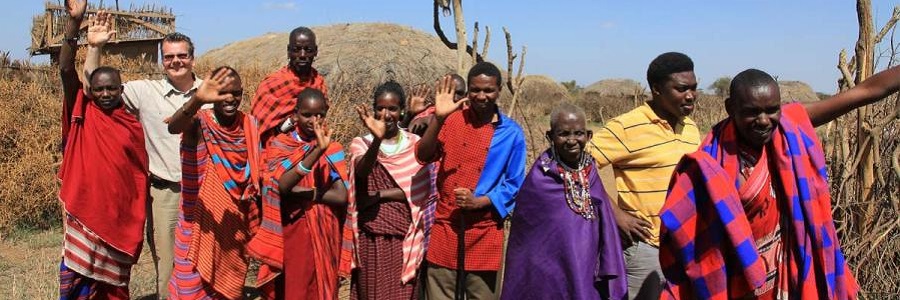
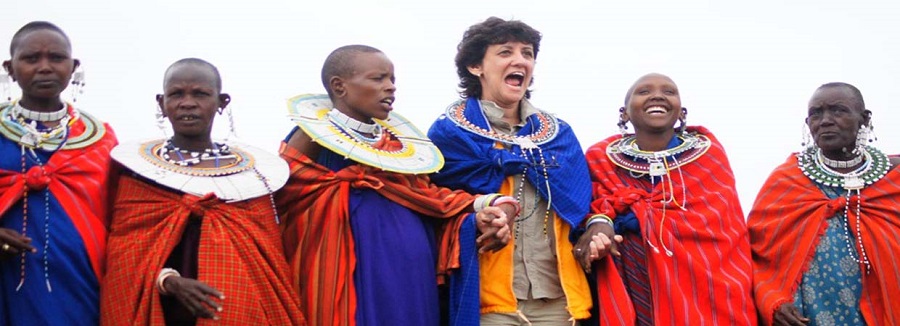

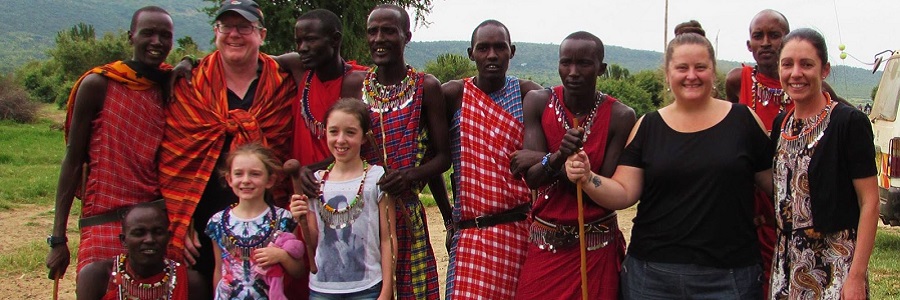
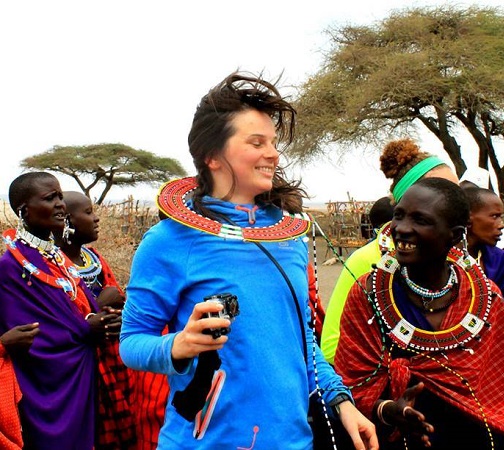

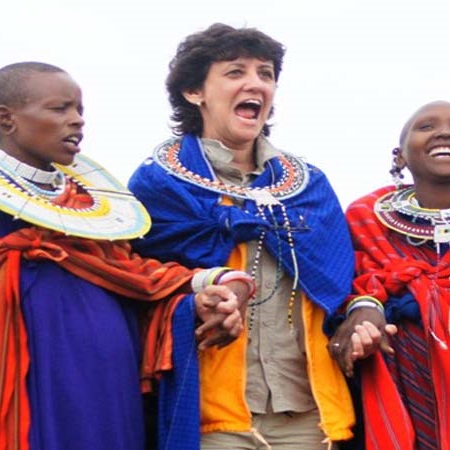
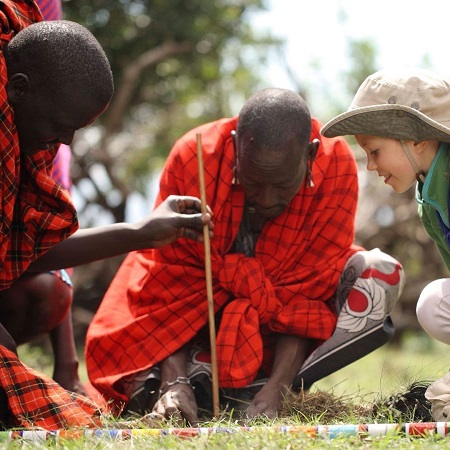
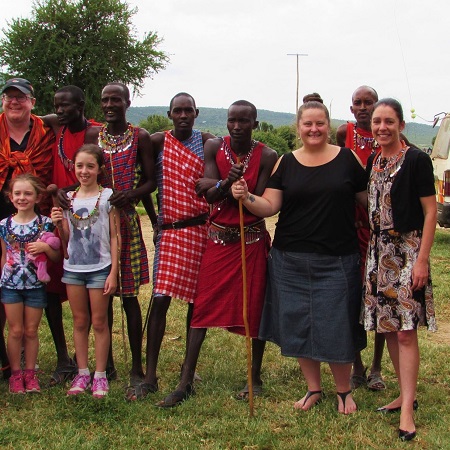
A Maasai Culture Village 1 Day Trip offers a unique opportunity to immerse yourself in the rich traditions and way of life of the Maasai people. This excursion typically includes interactions with Maasai villagers, witnessing their customs and practices, participating in cultural activities such as traditional dances, learning about their rituals and rites of passage, and experiencing firsthand the construction of manyatta huts. Visitors can engage with Maasai warriors, known as morans, and gain insights into their roles within the tribe. The day trip often involves trying local cuisine, crafting traditional Maasai jewelry, and engaging in meaningful exchanges with the community members. Overall, a visit to a Maasai culture village provides a deep appreciation for this ancient culture and its enduring traditions.
A visit to a Maasai village is an enriching experience that offers tourists a glimpse into the unique culture and way of life of this iconic African tribe. Located in the Southern areas of Kenya, primarily around Masai Mara, Maasai villages are typically situated on the fringes of the game reserve. Visitors can interact with the Maasai people, learn about their customs and practices, and witness their distinctive dwellings known as manyattas.
The cost to visit a Maasai village varies between USD 25 to 50 per person depending on whether it is included in a multi-day Masai Mara safari tour or if one is flying in on a package safari. The fee includes road transfers from your lodge or camp in Masai Mara and a contribution towards the village. Once at the village, visitors may be expected to buy souvenirs or curio items from the villagers, although this is not mandatory after paying an entry fee.
Maasai villages consist of clusters of manyatta huts, which are low-height structures made of mud, cow dung, and wood with minimal side windows. These huts form homesteads or bomas that can join together to make larger villages. Inside the manyattas, there are earthen stoves and firewood used for cooking meals without piped water, electricity, or gas. The traditional Maasai villages still exist in this manner despite modern developments nearby.
One unique aspect of Maasai culture is the Morans – warriors who undergo rites of passage to attain their status. Tourists visiting a Maasai village may have the opportunity to observe Morans displaying their jumping skills or even try jumping themselves. This cultural exchange provides visitors with an unforgettable experience that showcases the rich history and traditions of this remarkable African tribe.
In the morning we drive to Olpopongi in West Kilimanjaro region. Olpopongi is 74 kilometers from Moshi. Our two hours drive will apprehend us over the lovely outback of West Kilimanjaro. Depending on the season you can see game bepartialto zebras and elephants. On distinct days you'll have incredible views of Mount Kilimanjaro and Mount Meru. We reach Olpopongi first Lunch time, where we'll be welcomed by the local Maasai with a familiar welcome song and dance. We win a stroll around the village and you'll check-in your hut so as to the night. The guides will later grasp you to the cherished petite museum, where you'll ascertain about the history, social organization and tools of Maasai people. In-between our lesson a traditional Tanzanian lunch will be served to give you enough energy for an exciting afternoon. Later in the afternoon drive back to Moshi.

• Transport
• Village fees; Museum tour and Bush walk
• Driver guide, local English speaking Maasai guide and cook
• Traditional lunch
• Traditional lunch
• Personal items
• Gratuities / "tip" for guides
• Sodas and alcoholic beverages

Individuals that don’t know, Moshi is a medium-sized town located in the foothills of Mount Kilimanjaro in Tanzania. And while the famous mountain might be the main attraction in Moshi, this vibrant town is also the gateway to many other attractive and inspiring places that will give you a taste of East Africa.

If you haven’t already booked your Northern Circuit safari before you arrive in Tanzania, then Arusha is a good place to do it as there are no shortage of safari companies offering trips to the Serengeti National Park, Lake Manyara National Park, the Ngorongoro Crater, and Tarangire. Lake Natron is also another destination that you can travel to from Arusha.

The main attraction in Tanzania, a climb to the “Roof of Africa” is a once-in-a-lifetime adventure. Rich in diverse flora and fauna, Mount Kilimanjaro stands at 5,895 metres making it the tallest mountain in Africa and the world’s highest freestanding mountain. The Mount Kilimanjaro climbs usually take from 5 to 10 days depending on your time, ability and budget. There are several routes to choose from, with each one taking you through different climate zones, from equatorial rainforests surrounded by banana and coffee plantations to near arctic conditions. If you don’t have the budget to make it to the summit, there’s also the option to explore the base of the mountain with a day hike through Montane Forest.

The Maasai are probably one of East Africa’s most emblematic tribes and are easy to spot around Moshi with their distinctive look. You don’t have to walk very far to be greeted by a friendly, tall male Maasai wrapped up head to toe in a boldly coloured shúka cloth. But if you would like to learn more about these indigenous people, spending some time with them in their own communities is a great way to do it. It’s important to do your research though if you would like an authentic experience, as there are a number of trips that are tourist trips.
Lake Chala is the perfect place to get some downtime from the hustle and bustle of city life. Located just 1.5 hours away from Moshi on the border of Tanzania and Kenya, this tranquil location is one mighty fine example of how much natural beauty Tanzania has to present to you. Lake Chala is believed to be the caldera of a volcanic eruption which happened over three million years ago. Now all that remains is a beautiful blue lake surrounded by lush green forest, where you can see an abundance of different monkeys and birdlife.
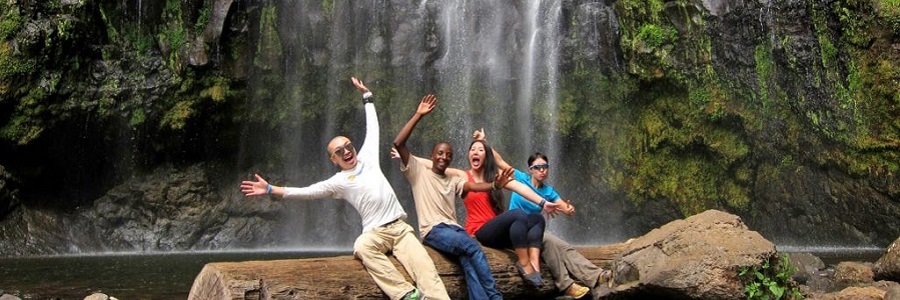
A shot distance away from Moshi town centre lies the Materuni Waterfalls. A day tour will begin with a short hike to the waterfall where you can make a splash in the mountain water of Kilimanjaro and enjoy beautiful and stunning views of the surrounding valleys. Along the way, you’ll also get to experience the local life of the Chagga people and on the way back you’ll stop by a traditional farm to view and witness how coffee is produced – from picking the bean to roasting and then drinking a tasty cup personally.
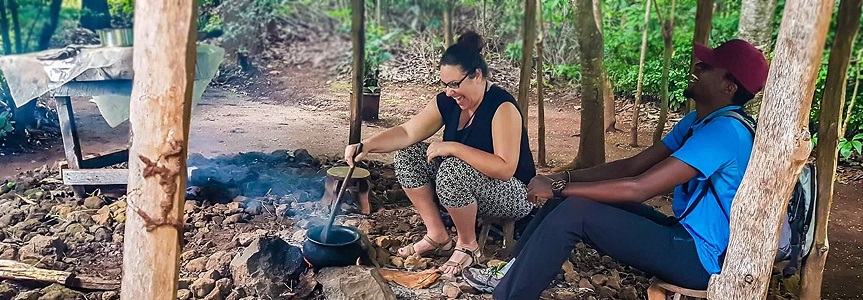
Moshi might be considered a small town, but you will be surprised by the variety of hotels and restaurants to choose from. From European and Asian foods to Indian and Italian cuisine, there is a world of food to be found in the town centre. But perhaps one of the best ways of experiencing local life is to sample Swahili dishes.
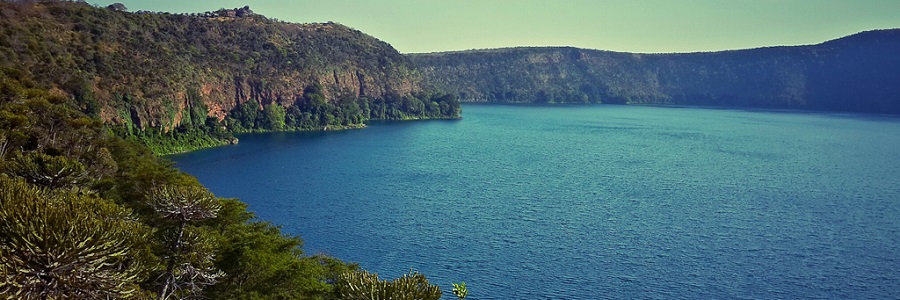
Located approximately 1.5 hours away from Moshi, Kikuletwa Hot Springs is one of Tanzania’s many hidden gems. A beautiful natural pool hiding away among twisting fig trees in the middle of a dusty landscape, this little oasis is a great place for relaxing. The crystal clear waters are a lovely warm temperature waters and you can even enjoy a free fish pedicure with all the tiny fish that nibble away at your feet.
Not only can you get great views of Mt Kilimanjaro on a clear day, it’s a great place to while away a few hours and people-watch as most of the locals still walk along the tracks as part of their daily commute. The best time to go down is before sunset when most of the locals are coming home from work. Plus they’ve converted one of the booking offices into a small bar where you can grab your local beer of choice – I’d recommend a Kilimanjaro beer.
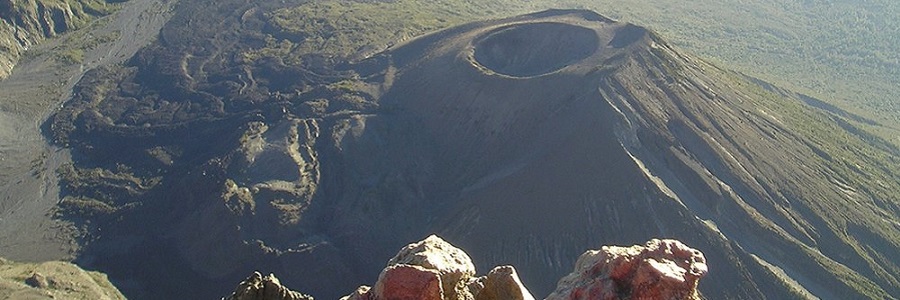
If Mount Kilimanjaro is a little out of your financial budget, Mount Meru is a great alternative for a more affordable trekking challenge. Standing at 4,566 metersabove sea level, it is the second highest mountain in Tanzania and some climbers even consider it more a beautiful hike than Kilimanjaro. Located in Arusha Park, with the Momella Lakes close to its foot, Mt Meru boasts diverse flora and fauna, and you may even be lucky enough to see some zebras and buffalo on your way up.
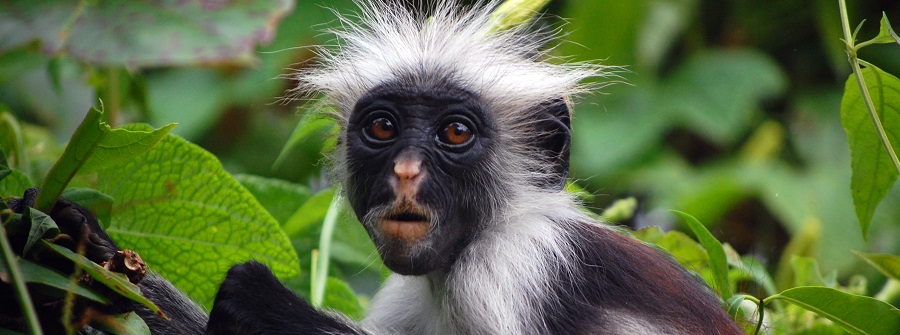
Kilimanjaro Animal CREW is portion of Makoa Farm, a gorgeous and beautiful lodge located on the slopes of Mt Kilimanjaro, and their major purpose is to educate people about animal conservation. A large part of the farm looks after orphaned or injured animals, providing a safe haven for a variety of different magnificent species. Visiting the farm is a great day trip for those who love animals. You not only get to go on a hike with the monkeys who freely follow along, you also get to meet some of the other residents of the farm including a three-legged serval cat, a duiker, bush pigs and a rather bad-tempered marabou stork ,to name only but a few of these animals.
If you want to go bargain-hunting or simply want to see the authentic side of local Tanzanian shopping, exploring the bustling local markets is a great activity to do. These markets mainly sell fresh fruits and vegetables, second-hand clothes and other essential household goods. You can also shop for kangas, the colourful materials you’ll see the local women tie around their waists. Memorial Market in Soweto is a short dala dala ride from the town centre and the best place to just wander around and take in the vibrant vibes.
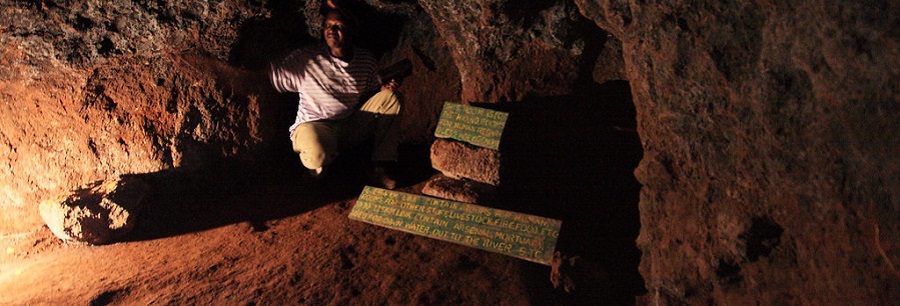
Experience life on the slopes of Mt. Kilimanjaro and visit Marangu Village. Highlights include meeting friendly coffee farmers, visiting the waterfalls and a local Chagga museum, eating local dishes and drinking home-brewed banana beer. There is also the opportunity to visit the colorful local markets and see the historic caves that were used as hiding points from enemies during clan wars.

There are many different NGOs and organisations in Moshi that offer various different volunteer activities, from women’s projects to teaching programmes or medical clinics to manual activities. If you’re looking to do something that gives back to the community during your stay, get in touch with organisations to see if there are any projects that match your skills and preferences and passions. Remember, it’s important to do your research when volunteering abroad to ensure that what you are doing is sustainable and ethical.
Picture a beautiful island surrounded by crystal clear waters and blindingly white sands, where every sunset is more breathtaking than the last. You know, the ones you see advertised in almost every honeymoon magazine? Well, that’s exactly what awaits you when you go to Zanzibar – a postcard-perfect island just humbly lying off the coast of East Africa. If you want to escape Moshi for a week or two, then Zanzibar is the place to go and it’s relatively easy to get to from Kilimanjaro Airport.
In the centre of town, you’ll find the Maasai Market. It’s pretty touristy, but it’s still one of my favourite things to do in Ausha and you’ll find a great array of souvenirs on offer, such as paintings, clothing, jewellery and furniture – there’s a lot to spend your money on. If you want to visit a ‘real’ Maasai market, you’re best heading to the Monday Maasai markets just outside of town, which you can get to by a public minibus or by a taxi. These are markets that the locals visit and you’ll find a mix of good, not just souvenrs. You may be able to grab a bargain if your bartering talents are good. The nearest ones are at Kisongo and Nanya, but there are also markets in Mto Wa Mbu Village (aka Mosquito River) near to Lake Manyara and Rudugai near to the hot springs.
If you’ve ever been through Tanzania, you have probably visited the amazing and famous Meserani Snake Park, located just outside of Arusha town. The camp, run by BJ and Ma, is more than just a campsite.They also have a cultural museum, a Maasai market, a truck workshop and as you might imagine, a reptile house with a huge number of snakes. They have also a fun and often vibrant bar, which is adorned with all kinds of traveller memorabillia, including t-shirts and bank notes.

If you’re looking to pick up some attractive, beautiful, handmade crafts, head over to the Maasai Women Fair Trade Centre on Simeon Road. It’s an organisation set up to empower local Maasai women (MWEDO – Maasai Women Development Organisation) in the area through access to health and education .They also have a coffee shop serving food and fairtrade coffee.

Lake Diluti is a volcanic crater lake in the foothills of Mount Meru, surrounded by a rocky escarpment and lush green scenic forests. The area draws in many attractive and delighting birds, including fish eagles, grey heron, kingfisher and, egrets as well as butterflies, reptiles and primates, making it a great place for nature walks and birders.You can also take a guided canoe trip out on the lake with views of Mount Meru and Mount Kiimanjaro in the background.
Also known as the Old Boma Museum, this old structure, which was built by the Germans in the early part of the 20th Century, is now home to the National Natural History Museum. Divided into three parts, the museum houses an exhibit on the evolution of mankind, numerous of historical photographs ,as well as stuffed animals and displays of a variety of fossils.

If you are looking for a nice place to unwind and relax, head to the cool pool at the Mount Meru Hotel.
It is free if you are staying there, but if you’re not, you can pay to use the pool facilities, it costs around $15 for the day and there are showers and changing rooms, plus a bar and restaurant. It’s where you’ll find a lot of the locals and expats hanging out at the weekends.

Sidai Designs is another fair-trade initiative with the purpose of empower Maasai women in the area by providing employment and support and by selling beautiful handmade Maasai crafts, like jewellery, wall hangings and glassware. While you are there you can take a nice tour of the workshop and also have a try at making your own jewellery.
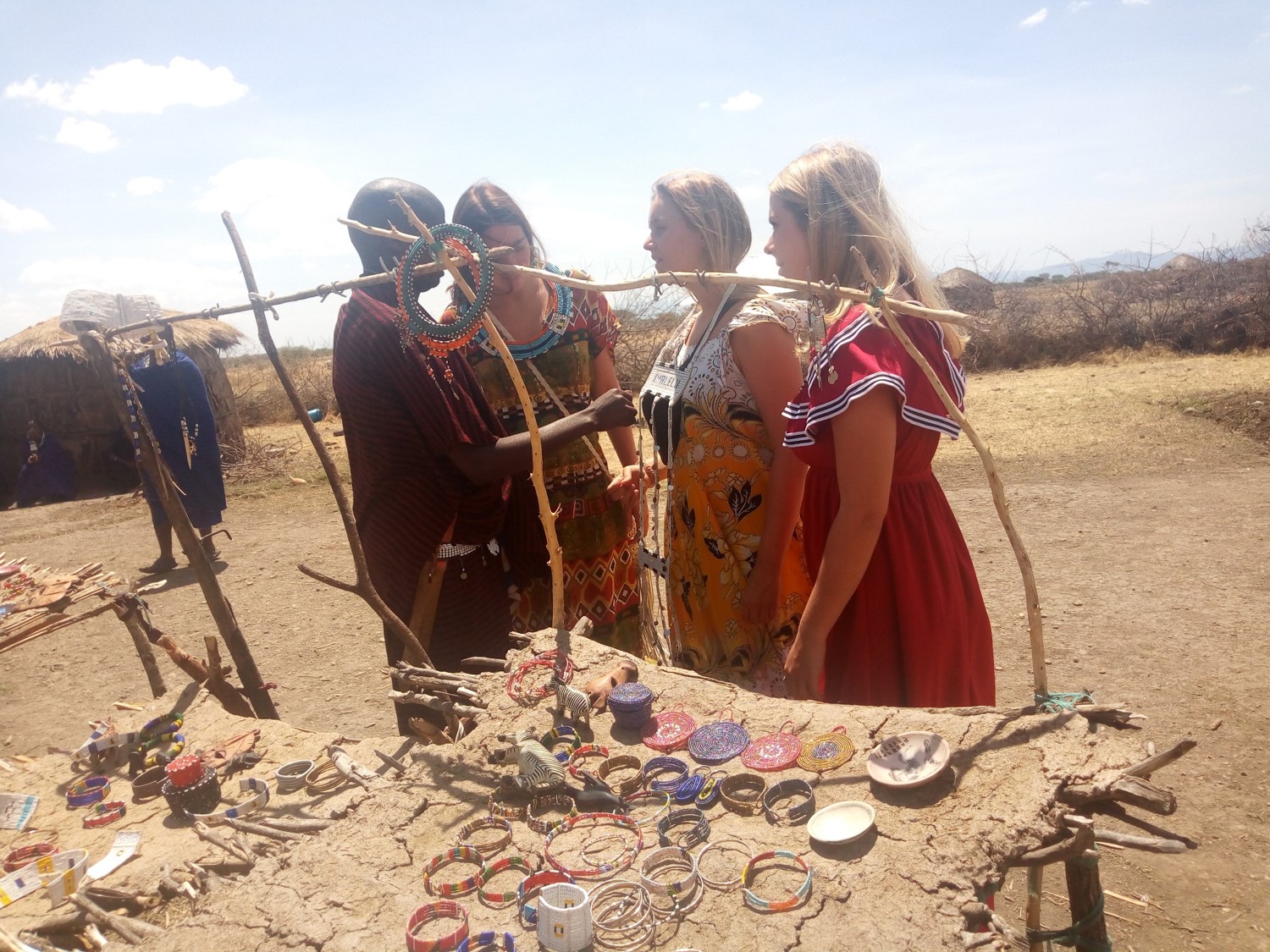
Shanga is a great initiative and social enterprise set in the grounds of Arusha Coffee Lodge that employs local Tanzanian’s with disabilities. Their aim is to support and empower people with disabilities to live independent lives. In the shop they sell beautiful jewellery , glassware, homeware and clothing all made on site. They also hold workshops where you can try activities such as beading ,glass blowing, and learn sign language.
Tanzanite is a beautiful blue/violet gemstone found in Northern Tanzania. You can get to know more about the history of the stone in the museum at the Tanzanite Experience and buy certified jewellery. For those interested in crystals and their healing properties, Tanzanite is a great stone for the throat, third-eye and crown chakras. It helps us with our communication, psychic abilities and facilitates communication with the spiritual realm. You surely would like to visit this museum.
The best way to experience any East African city is by visiting the local market .In Arusha, there’s the Central Market (Soko Kuu) and the Kilombero Market where you can buy anything and everything from food, wood carvings, jewellery, animals, clothes and household items. Be alert as pickpockets are common in crowded places like markets

Northern Tanzania and Kenya is where you’ll find the majority of the Maasai people, so if you’re interested to learn how they live, then this is a good place to do it. There are quite a few more authentic/welcoming Maasai villages than you can visit as a day trip from both Arusha and Moshi. Prepare yourself for some new perspective on the Maasai people!!
Outside of Arusha, on the way to Moshi, you’ll find the busy village of Usa River (said like Oo-Sa River, not U-S-A River). This is a great place to take a tour and learn about Tanzanian village life and the vibrant culture of beautiful people in this area.
Want to refresh and unwind after your safari or a trek up Mount Meru or Kilimanjaro? Then head to the spa at Machweo which is just on the outskirts of town on the way to Usa River and Moshi. It’s located in Onsea House, one of the most upmarket hotels in Arusha with incredible sceneries of Monduli Mountains. They have many different types of massage on offer including Thai, Swedish, D-Stress, Hot Stone or Chocolate, as well as sauna, manicures, pedicures, steam bath, and a few other treatments too.

As you drive to the Serengeti, you’ll probably pass the Arusha Cultural Heritage Centre which is an entire complex housing a museum, antique shops, gift shops, art galleries, a cinema, a spice centre, a restaurant, a spa… This place has a lot of information and details about the culture of Tanzania’s many cultural groups so it is really worth a stop if you have a chance and time!!!
We would like to welcome you in the village called “Kambi ya Chooka”. This village was founded by local Maasai and, differing from others that were purely built for touristic purposes; the local people are really living there. For sure this guarantees a much more authentic experience for our clients and is a main reason why we selected it for our clients.
We pick you up in the morning after breakfast and the ride will take you partly over bumpy slopes and dried river beds, baobab trees as well as small villages accompany you on your way.
When we arrive at the village you’ll be welcomed by the local Maasai and introduced to your Maasai guide; still our guide will always accompany you in case you need support, to help with language issues or just for taking nice pictures while you interact with the Maasai, if you like.
We’ll start with a walk through the village and will get useful information about the traditions in the meantime. After entering a typical house you’ll have the chance to dress like a Maasai for the further highlights of the tour: participating in a local Maasai dance – a unique experience which is lot of fun.
While getting further explanation about Maasai houses & typical family structures, you’ll have the chance to see traditional jewelry, which is produced by the local ladies. Questions are always welcome. To find a great final for our local experience there will be an interesting demonstration by Maasai men making fire in very traditional way with only wood, hand skills and dry grass – you’re welcome to try it as well.
Depending on the season you might also see the goats, which are kept within fences made out of thorn bushes near the houses and the men will take you on a quick walk to the water-area to see further sheep, goats & donkeys (subject to change based on weather conditions).
Finally the huge sugar cane plantation, which we will see on our way back, is impressive.
We’re very much looking forward to welcome you – karibu!
For a full day experience you can combine this with our “Kikuletwa Hot Spring tour” (combination price upon request), which is situated in the nearby area.
All guides speak English | includes bottled water, private transportation, picnic lunch and entry fees.
Maasai (not Masai) is the correct spelling of this noble tribe: it means people speaking maa. Masai was the incorrect spelling of the British settlers and has remained in current use. The Maasai have always been special. Their bright red robes set them apart visually. Spear in hand, they are calm and courageous regardless of the danger.
The armed British troops who drove the Maasai from their lands in the early 20th century had great respect for these fearless tribesmen. Up until recently, the only way for a Maasai boy to achieve warrior status was to single-handedly kill a lion with his spear.
MWCT works primarily with the Maasai living the the Kuku Group Ranch. The Kuku Group Ranch is home to around 17,000 people and lies in an important migration corridor of 283,000 acres that is at the base of Chyulu Hills, Hemingway’s, “Green Hills of Africa,” in between Tsavo and Amboseli National Parks.
This is home for East Africa’s most iconic wildlife including: lions; elephants; leopards; zebra and giraffes. The land contains important resources not just for the people of Kuku, but the habitat reserves, forests that are carbon sinks, and rivers and springs supply fresh water to more than 7 million people living in and around the port city of Mombasa, Kenya’s second largest city.
MWCT’s international team of experts works with the Maasai community on a knowledge-sharing basis to create and implement holistic and comprehensive programs in conservation, health, and education that serve the community, the wilderness, and the wildlife that are so important to us all.
Kenya recognizes over fifty tribes of native people. The Maasai were the dominating tribe at beginning of 20th century. They are one of the very few tribes who have retained most of their traditions, lifestyle and lore. In common with the wildlife with which they co-exist, the Maasai need a lot of land. Unlike many other tribes in Kenya, the Maasai are semi-nomadic and pastoral: they live by herding cattle and goats.
The Maasai have not fared well in modern Africa. Until the European settlers arrived, fierce Maasai tribes occupied the most fertile lands. The Maasai struggled to preserve their territory, but their spears were no match for armed British troops, and their lawyers never had a fair chance in British courtrooms. In 1904, the Maasai signed a first agreement, losing the best of their land to the European settlers.
Seven years later, in 1911, a very controversial agreement was signed by a small group of Maasai, where their best Northern land (Laikipia) was given up to white settlers. Surely they did not fully understand what the consequences of such a treaty were, and anyway the signatories did not represent the entire tribe. With these two treaties, the Maasai lost about two-thirds of their lands and were relocated to less fertile parts of Kenya and Tanzania.
Other tribes of Kenya have adapted more readily to the “progress” of modern times. In contrast, the Maasai have persisted in their traditional ways, so as Kenya takes more land for growing tribes and agriculture, they suffer.
Less land for an ever growing Kenyan population means less land for the Maasai, their livestock, and wildlife. More and more, a lion will take a cow or some goats and get killed in retaliation.
Lions are a disappearing species: their numbers plunged from 100,000 ten years ago, to about 14,000 today. Maasai Wilderness Conservation Trust has pioneered a compensation program, reimbursing livestock killed by lions (and other predators). The program is supported by Campi Ya Kanzi tourist conservation fees and employs warriors as lion scouts.
In the past, the Maasai and the wildlife simply lived together, in balance. If this could be re-established, by showing to the Maasai the economic value of the presence of wildlife in their land, the future of the land, of the wildlife and of the Maasai people will be assured.
This is exactly what Maasai Wilderness Conservation Trust does. We are thrilled by having been awarded the UNDP Equator Prize and by having had our Chairman, Samson Parashina, named Champion of the Earth by UNEP. Never before these prestigious United Nations Awards were given to the same organization.
Kuku Group Ranch, where the camp is located, has 400 square miles of land and is occupied by only a few thousand Maasai. The land is rich in wildlife. It adjoins Tsavo West National Park, Chyulu National Park and Amboseli National Park, representing a vital corridor and a dispersal area for these three National Parks.
The Trust employs 300 members, as teachers at the schools, rangers and game scouts to protect wildlife, a doctor and nurses at the dispensaries. Thus, by sharing their vast lands with a maximum of 16 visitors from Campi ya Kanzi, the Maasai of Kuku Group Ranch benefit in several ways: They maintain their lands in a natural state. They are partners in generating income which improve their life conditions and their children’s education. They preserve their traditional way of living and dignity.
What Campi ya Kanzi and MWCT are jointly aiming to achieve, is being able to pay “conservation dividends” to all the individuals of the Group Ranch, so that the land can be preserved as a unity, owned under one single title deed, and not subdivided. This will guarantee that those Maasai willing to keep embracing their lifestyle, will have a place to do it.
Your visit to the camp helps the Maasai retain their heritage. You will not leave by having taken something away, you will leave Campi ya Kanzi enriched by a human experience that, hopefully, will accompany you for years to come.
Immerse yourself in authentic Maasai culture as you visit a traditional village, accompanied by an English-speaking guide who lives there himself.
Find yourself in the midst of the daily hustle and bustle of local life as you witness the daily rituals of the Maasai. Once you have drunk your fill of this authentic cultural experience, you can choose to browse through the Maasai Craft Centre and purchase artefacts made by the people you encountered. All proceeds from this go directly to the community.
Living a semi-nomadic lifestyle, the Maasai tribe has modernised in some ways but still adheres to many aspects of their traditional culture. Established as fierce warriors, their lively cultural dance, vibrant clothing and beautifully crafted handiwork are recognised worldwide.
The Maasai used to move nomadically with their herds to abundant lush pastures but these days they have built permanent huts or bomas and prefer to stay in once place. They are pastoralists and cattle is essential to their way of life. A man’s success is measured by the number of cattle and offspring he has. As great a status and show of wealth the cattle are, they are also a vital food source. This glimpse of authentic Maasai culture is a fascinating experience of an ancient way of life that still flourishes today.
Driving from Moshi, you pass beautiful plantations of bananas, yams, potatoes and coffee, en route to Kinumakori Waterfall. Kinumakori Waterfall in Marangu is not the highest, but is a beautiful walk that enables you to see the waterfall both from the bottom and the top. At the waterfalls, you can relax amongst tranquil nature and swim in the cool waters.
The waterfall is located near Marangu village, which is a typical village of the Chagga people, at 1800 m above sea level.
At the village, we will visit the Chagga cultural centre. Also, we will visit caves where the Chagga people hid during the war. In the village, you will furthermore see the traditional Chagga houses and visit the family of a coffee farmer. Together with a guide, he will explain to you, stage by stage, on how to prepare coffee - from picking ripe coffee berries to the final cup of delicious hot coffee.
This trip includes the waterfalls, cultural centre, underground caves, coffee farmer, visit to the Chagga house, a lunch box, 1.5 litres drinking water, banana beer, transfer to and from the village and guide costs.
The Chagga are Bantu-speaking indigenous Africans and the third largest ethnic group in Tanzania. They are also called Wachaga, Chagga, Jagga, Dschagga, Waschagga, or Wachagga. They traditionally live on the southern and eastern slopes of Mount Kilimanjaro and Mount Meru, and near Moshi. Their livelihood is through taking advantage of the favorable climate of the area and successful agricultural methods, which include extensive irrigation systems, terracing, and continuous organic fertilization methods that have been practiced for thousands of years. They were one of the first tribes in the area to convert to Christianity. This may have given them an economic advantage over other ethnic groups, as they had better access to education and health care.
The “Marangu Waterfalls” is located on the slope of Mt. Kilimanjaro national park, is also an excellent location for hiking, bird watching and taking in the sights of rural Africa. The cultural tourism program offers the opportunity for visitors to watch traditional blacksmiths, visit nearby caves and waterfalls as well as experience life in the local chagga tribe. People around Marangu village are very welcoming and we hope you will enjoy your time with them. While in Marangu one can learn more about the chagga culture by visiting a traditional chagga house made of straw roofing. Also the traditional food made by bananas and local brew known as Mbege can be tasted
At the waterfalls, you can even refresh in cool and crystal clean water. Don’t forget to bring your swimwear! Here you will also break for lunch before doing a short tour of Marangu village to see the typical life of local tribe/people
In the morning we will pick you up from your hotel in Arusha. Afterwards you will undertake an approximate two and a half hours scenic drive along the slopes of West Kilimanjaro up to the Maasailand near Tinga-Tinga. After arriving at „Olpopongi“ Maasai Village a group of pleasant Maasai and the Village Chief welcomes you with a chilled welcome drink. During a walk through the village, your personal Maasai guide is explaining the life, past and today’s life of the Tanzania Maasai. Get more information about the culinary culture of the Maasai while tasting a traditional tea (chai) prepared on the wood fire. A tasty lunch with a variety of local food highlights will end the activities inside the village. The afternoon starts with an exciting & very educational walking safari across the nearby bush. Maasai warriors will guide you along their paths and explain you typical medicinal plants, extraordinary trees, tracks and the local wildlife. In addition to that, the usage of local tools, hunting techniques and fire preparation is a part your unforgettable bush excursion. Coming back to the village, the well-deserved break is accompanied by freshly brewed coffee & cake. During the sunset a group of Maasai men and woman gathering around for the traditional singing & dancing performances. A great BBQ-Buffet right at camp fire and the „get together“ with your already known Maasai friends, will provide you an unforgettable evening under the (mostly) starry sky. The evening will find the end at your private Maasai house on traditional beds with comfortable mats & blankets.
After hearing the rhythm of the bush drums next morning, the breakfast with freshly baked rolls, jam, fruits and an omelette of your choice is waiting for you! Later, during the still early morning, the tour is over and it’s time to say good bye with many new impressions in your mind. Your driver will bring you back to your hotel in Arusha.
Lunch; BBQ-Dinner; Breakfast
The Maasai are one of Africa’s oldest and most recognizable tribes, with nearly a million of these nomadic people living amidst the unforgiving plains of Tanzania and Kenya. Here’s what you need to know about experiencing this traditional culture while in Kenya. Spend a day touring Ngong Hills, the homeland of the Maasai tribe in Kenya. Follow a Maasai guide through Loita Forest to immerse yourself in the traditional way of life, while learning survival skills and local customs from the Maasai. Learn the art of traditional Maasai jewelry-making from a local artisan (and take home your own creation). Sample some of the proteins critical to local communities—ostrich, crocodile, and camel among them—roasted on Maasai swords over an open charcoal pit. Tour the Bomas of Kenya heritage village to learn more about each of Kenya’s 42 ethnic groups, including the Maasai. Shop for arts and crafts handmade by Maasai women at Maasai Markets.
Cultural tourism in Tanzania allows tourists to have a rich understanding of the people living in and around the national park areas. You will learn, first hand, the customs, the traditions and the cultures of villagers and come to appreciate their way of life. At times, you may hear ancient stories of the wildlife and ancestral tales that attempt to explain natural phenomena.
Cultural tours allow us to learn about a people who, at first, may seem to be different, but as you learn about them and their natural environment, you realize that people are not very different from one another. We hope that you will find these cultural tours in Tanzania are both enjoyable and memorable.
Please note that We have no itineraries for Tanzania culture; however, you may request that one or more programmes be included in your custom/tailor made itinerary.
The Maasai are a Nilotic group, migrating to eastern Africa by way of southern Sudan in the lower Nile valley around the 15th century. They settled in the Great Rift Valley stretching from what is today northern Kenya to central Tanzania between the 17th and late 18th century. They raided cattle using spears and shields, but were most feared for throwing clubs which could be accurately thrown from up to 70 paces.
The Maasai (Masai) could be the most known Kenyan tribe outside Kenya especially for tourists The Maasai (Masai) are more commonly associated with Kenya, but they've been a presence around the Ngorongoro Crater of Tanzania for over a 150 years and are the area's main residents. They are predominantly a warrior tribe whose lives revolve around herding cattle. They believe the rain God Ngai entrusted the cattle to the Maasai (Masai) people when the earth and sky split, and wealth is measured in number of cattle. Since cattle was given to the Maasai (Masai), they believe its okay to steal from other tribes.
A stereotypical image most people have of the Maasai (Masai) warrior is that of a tall and slender man clutching a spear in one hand with his red cloth wrapped around his waist or over his shoulders. The Maasai (Masai) men are also seen in a trance like state jumping in a uniform motion in one spot, this brings them to a trace like state and can go one for hours.
The Maasai (Masai) drink cows blood that they believe makes the body stronger and warmer and is good for children and the elderly to build up their strength. It is often drunk mixed with the milk of the cow. An arrow is shot at close range to puncture the jugular vein of the cow. The blood is drawn into a skin gourd and later mixed with milk to be drunk by the gathering. The animal is not left to bleed but is carefully tended to, till it fully heals. Their rites and traditional ceremonies are taken very seriously, and it is not common to allow outsiders to attend. Elders play a very important role in the community and society at large.
People of the Maasai (Masai) tribe live in small settlements of 8-15 huts per village; the kraal (a traditional house or hut) is surrounded by a thorn bush fence, which acts like barbed wire, protecting the tribe and animals against enemies. The huts are built using branches, twigs and grass with a cement of cow dung and urine, and inside animal skins and cushions of dry grasses are used for comfort. The mixture is as strong as cement after it dried in the sun and does not smell. They cannot stand up straight inside the hut and the only openings are that of the doorway and a small opening in the roof or wall which allows smoke from a continually blazing fire inside to escape. Dried cow dung is used to fuel the fire. The family sleeps on beds of woven branches cushioned with dry grasses and animal skins.
Maasai (Masai) women and girls have numerous chores besides building the dung hut, which take about 7 months. It is their responsibility to milk the cows and fetch water, whatever the distance may be. The Maasai (Masai) women are also expected to pick calabashes or gourds from vines and clean the insides of the gourds as well as decorate them with leather and beads. A woman is by birth a member's of her father's family line and cannot own land or cattle. They are minors in society, always represented by their father, and later their husband. If a woman has no sons in her marriage she will be scorned and forced to beg in her old age, as she will have no possessions or money and no one to care for her.
For the boys, fifteen is the coming of age ritual, when they become circumcised and become Morani (young warriors), formally they would hunt a lion with a spear during the rites of passage ceremony but lion hunting is now illegal.
Children of the tribe have importance in rituals like rainmaking during a drought when the children sing for the rain. Playing "sheep's and goats" is a common game for children, an equivalent of "cowboys and Indians". Teenage boys make trouble playing with the cattle and playing "knock down ginger" with a cow replacing the door! They are known for their tradition of hair plaits, heavy iron necklaces, and fierce warriormanship, often depicted carrying a spear. The Maasai (Masai)'s unique hair is a clear living symbol of their tradition and culture. By wearing the plaits, it proves the individual is a true Morani sticking to their own traditions.
Nowadays, Maasai (Masai) boost their income by selling beads, masks, and carvings to tourists. In a curious way, tourism helps the Maasai (Masai) to retain and develop the Maasai (Masai) culture by transforming their believes into a business. The ceremonies you will see being performed as a visitor are traditional but they are staged for the tourist audience. It doesn't destroy the Maasai (Masai) culture because the tourists don't change the fundamentals of Maasai (Masai) living, only observe, whilst helping to rejuvenate centuries old customs.
Cultural tourism has become a fundamental part of the tourism industry in Tanzania spearing an increase in tourist arrivals into the country, thus empowering rural communities to reap the fruits of globalization and the ever growing tourism industry.
There are several cultural heritage sites scattered throughout the country where you can spend from half day to a week with one of the 120 distinct ethnic groups making up the population.
At the sites you will experience authentic, indigenous cultures by combining nature, scenery, folklore, rituals, art & crafts, ceremonies, dances and local hospitality of Tanzania to give a unique perspective into the daily lives of the local people
Your cultural tour will directly support the villages desire to become more self-sufficient, preserve their indigenous culture, and aid environmental conservation efforts.
Babati and Hanang, Engaruka, Ilkiding’a, Longido, Mto wa Mbu, Ngorongoro, Lake manyara.
The Maasai Tribe is one of the most renowned African tribes. Although the tribe is made of just a small population, it is still one of the biggest attractions in Africa. The Maasai are found in Tanzania around the Ngorongoro crater, but there are also some living southern Kenya, it is believed that they have been there for over a century and are the main residents of the Ngorongoro area.
If you have plans on going for a safari in Tanzania it is likely that you will come across a local Maasai villages or be given guide on their traditions and history.
The Maasai is one of the few tribes in Africa that still live the way they have for decades honoring their culture, traditions and history. even though it not easy to ignore the influence of the outside world and modern culture. Their culture has not remained static, it is transforming, but its beliefs and core remain strong
Babati district is located along the Arusha-Dodoma road in the Rift Valley, south of Lake Manyara Park and west from Tarangire. The town boasts Lake Babati where floating hippos can be seen and which is rich in fish, both tilapia and Nile perch. Here commercial and farming tribes co-exist with conservative cattle herding tribes to provide a distinguished cultural contrast. In Hanang District close by the beautiful Mount Hanang (3418m), live the Barbaig people whose traditional culture is still unchanged and unspoiled. The women wear traditional goatskin dresses and the men walk around with spears. Visitors can mix freely with the Barbaig, commonly known as the Mangati living in the Mangati plains. If you are interested in bird watching, 400 bird species will welcome you on your walks in the area
You walk to Managhat village and climb Bambaay Hill from where you see the beautiful Rift Valley landscape with Lake Babati and Lake Manyara and the Maasai Steppe to the east. Later, visit a respected Gorowa tribesman, Mzee Kwaraa, for an insight on Gorowa culture, marriage ceremonies, rain prayers, burial, religious and circumcision rituals. Optionally, you can row, fish and view hippos on Lake Babati using local canoes.
The Longido is about 90 kilometers north of Arusha Town. It is one of the places to visit and see Maasai peaple and other tribes like Wa-Arusha. Visitors have a chance to see cattle being auctioned in the market and how local people (Masai and Wa-Arusha) conduct that business traditionally. the Masai are benefiting from 'green' tourism by organizing tours of the mountains and plains near their community.
The safari takes you through the plains that are home to different species of birds; mountains around the area (Longido and Ol Doinyo Lendaree)
with beautiful terrain that allows hiking to take place. Depending on a person's physiology, hiking can be done just for one day to the top. Once at the top you have a good view of mount Meru and Kilimanjaro Mountain as well as Maasai plain in Kenyan Side on a clear day. Get a Chance to see and learn a little more about the pride of Masai Pastoralists in Tanzania.
The tour guides fill visitors with fascinating information about history, culture, and the natural world. And visitors get to enjoy a traditional meal prepared by Masai women. A portion of the tour fees go into a village fund that finances local development projects. Longido offers a guided tour hiking to Kimokouwa, along with Maasai cattle trail, that winds over the slopes to the summit of Longido mountain.
The Hadza people, or Hadzabe’e, are an ethnic group in central Tanzania, living around Lake Eyasi in the central Rift Valley and in the neighboring Serengeti Plateau. The Hadza number just under 1000. Some 300-400 Hadza live as hunter-gatherers, much as they have for thousands or even tens of thousands of years; they are the last functioning hunter-gatherers in Africa. Cultural Tours
The Hadza are not closely related to any other people. While traditionally considered an East African branch of the Khoisan peoples, primarily because their language has clicks, modern genetic research suggests that they may be more closely related to the Pygmies. The Hadza language appears to be an isolate, unrelated to any other.
Cultural tourism in Tanzania started as a program to help rural communities enjoy the benefit of tourism sector in which they are a part of. The program is the effort and initiatives of the Dutch Development organization know as SNV which has been directly involved in Tanzania's community development programs, especially in the rural areas. The main goal is that rural communities should directly benefit from tourists who visit their areas. Cultural tourism allows local people such as Maasai, Pare, Sambaa, Wa-arusha, Gogo, Nyakyusa and Wazaramo to offer tours that show their culture, their sacred places of worship, economic activities, for example, farming, pastoralism and fishing.
The income generated is used by local people for specific development programmes, such as, the building of dispensaries, schools and cattle dip sites.
BABATI/HANANG - 170 kms from Arusha
Rift Valley/Gorowa Culture - A special Barbaig cultural insight hike - An exclusive Mt. Hanang Climb - A fishing adventure with local canoes while viewing hippo's on Lake Babati - Gorowa story teller with information on rituals
.
ENGARUKA - 180 kms from Arusha
Ruined city/Maasai - A guided walk through the mysterious ruined city - Thorough description of the past and present irrigation systems that keep the village green. - Bird-watching walks at the foot and slopes of the Rift Valley Escarpment.
ILKIDING'A - 7 kms from Arusha
Slope Meru/Wa Arusha - A view into Wa-arusha culture by visiting traditional healer and by tasting traditional food. - Walks through the fields on the slopes of Mt. Meru. - Visits to craftsmen who produce stools, knives, jewellery and other traditional objects.
KISANGARA - 90 kms from Moshi
Nyumba ya Mungu Dam - Fishing expeditions at Nyumba ya Mungu Dam. - Spice tour and cooking traditional dishes - A visit to the Lembeni Herbal Hospital.
LONGIDO - 81 kms from Arusha
Maasai/Mt. Longido - Walking safaris with Maasai warriors. - A climb up the impressive Longido Mountain - A view into the culture and daily life of the Maasai
MAMBA/MARANGU - 30 kms from Moshi
Slopes Kilimanjaro/Chagga - Walks by numerous waterfalls through lush green valleys with panoramic views of Kilimanjaro. - Visits to ancient hiding caves used during tribal wars. - Visit to blacksmiths using traditional methods.
MKURU - 50 kms from Arusha
Maasai/Camel ride - A visit to the camel camp at the foot of Mt. Meru - Camel safaris varying in length half a day to one week - Bird-watching in the plains around Mkuru - A climb up Ol Doinyo Landaree, a pyramid mountain
MTO WA MBU - 120 kms from Arusha
Mixed tribes/fields/rift - A walking tour of the farms and surrounding area at the foot of the Rift Valley - A trip to the Miwaleni Lake and Waterfall - A thorough explanation of the irrigation system - A view into the culture of the different tribes.
NGIRESI - 6 kms from Arusha
Slopes Meru/Wa Arusha - A guided tour of farms on the green and steep slopes of Mt. Meru - A view into the Wa-arusha culture (traditional health care, building styles) - A visit to several development projects
NORTH PARE - 110 kms from Arusha
Pare Culture/hills - A walk through Kindoroko Forest Reserve - Thorough explanation on medicinal power of plants and herbs growing in the area - A view into the Pare culture (old stories).
SOUTH PARE - 160 kms from Arusha
Pare Culture/Mountains - A walk through the Chome Forest Reserve - A climb to Shengena Peak, the highest point in the Pare and Usambara Mountains - Walks to the Tona Moorland and Ranzi Dam
PANGANI - 350 kms from Moshi
Coast Culture/slave history - A visit to a former slave labour camp and slave market site - A river cruise through the vast coconut plantations - A walk through Pangani historical town - A fishing experience with local fishermen
WEST USAMBARA - 270 kms from Moshi
Wasambaa/Mountains - A visit to viewpoints on the edge of the mountains. - Hikes through dense natural forests and along small tumbling rivers - Visits to irrigation and soil conservation projects.
For the average tourist, a visit to Tanzania usually involves jetting in for a whistle-stop safari then zipping off to Zanzibar for a few days. But there's more to Tanzania than that. With a cultural tours programme in place, travellers now have no excuse if they don't get to meet the local people and experience the real Africa. The Maasai clan of Mkuru lead a very isolated life. Pelo, the 68-year-old chief, and his family have never travelled far from their home in the foothills of Mount Meru. To them, northern Tanzania is the world. Their only contact with others is a weekly visit to the big market and meeting the occasional traveller who journeys to Mkuru for a camel safari.Since camels were introduced to Tanzania in the early nineties, the Maasai have come to appreciate these animals in the dry semi arid plains between Mount Kilimanjaro and Lake Natron.
For many, quality of life has suffered. Cattle died from starvation, forcing some warriors to become poachers simply to get food to survive. The Maasai learnt to loath conservation and tourism.But at Mkuru, their attitude to tourism is changing. The camel safaris and Maasai experience are one of the new cultural tours recently launched in Tanzania that give visitors an insight into the daily life and culture of the local people. The cultural tourism programme was established in 1997, with supervision and training provided by the Tanzania Tourist Board and the Netherlands Development Organisation (SNV).'The aim of the project is two-fold,' says Miet van Spittael, the Dutch coordinator based in Arusha. 'It is a five year plan that is already benefitting the local people by helping them earn extra income and assisting them to improve their lives.They have been trained how to conduct guided tours showing visitors what their life and culture are about. After the five year period, the project will have become a self-supporting scheme.' But it's not only the locals who profit from the programme. This unique taste of Tanzanian culture offers tourists a fresh glimpse into this beautiful land.'It's of major benefit to the locals, but at the same time,' continues Miet enthusiastically, 'the tourists get unforgettable memories of the African people and a much richer experience of the local culture.'The average itinenary of a Tanzanian tourist involves jetting in for a whistle-stop safari. Then zipping off to Zanzibar for a few days of Stonetown and the sea. Mount Kilimanjaro, the game reserves and coral reefs may be the major tourist attractions of east Africa. But there's a lot more to Tanzania than that.The fourteen cultural tours are spread out at small villages, mainly around northen and north eastern Tanzania. The guided excursions also include panoramic hikes in some of the most spectacular mountain scenery you could hope to find.Under the watchful eye of Miet and her guides, the income from tourism goes directly back to the local community to help with social upliftment and education programmes. The funds are used for very specific purposes, such as improving schools, buying energy-saving stoves, building cattle dips and mending irrigation canals.I've had my yellow fever injection and my Hepatitis-A shot. Stocked up on Larium and got my cholera vaccination certificate. All set for my east African culture class. Thoughts of the rugby world cup fade into the distance as my Air Tanzania flight banks low towards the sunset over Kilimanjaro International Airport.As we drive towards Arusha, visions of Africa sooth away my tiredness. Baobob and acacia trees stand silhouetted against the purple sky. Smiling Maasai men wrapped in their distinctive red blankets watch us from the roadside. The dusty landscape glows gold in the African night.Early the next morning, we meet up with Miet before setting off to the slopes of Mount Meru and the village of Ng'iresi. A veteran of fifteen climbs up Mount Kilimanjaro, 'mamma Mietie', as she is endearingly called by the locals, has very definite views on the cultural path ahead.'If you travel to Ngorongoro or the Serengeti, you see so many Maasai on the side of the road just waiting for tourists,' she says solemnly.'The women dance and sing and the children beg for sweets. This is not what we want from tourism. By performing like this, it disrupts their daily lives and destroys the hearts of the people and their traditions. We want tourists to rather come and visit the locals in their villages where they can get a proper insight into how they really live.'The 2700 inhabitants of Ng'iresi are of the Wa-arusha tribe. Farmers who all depend on agriculture and produce of land for survival. We are welcomed by 'Mzee' Loti Sareyo ('Mzee' is a term of respect for addressing an elder) and his wife Lightness, chairperson of the Juhudi Womens Group.Ng'iresi perfectly illustrates a village making a harmonious transition from traditional into modern African life. One of the most impressive examples is the Traditional Irrigation Programme where the SNV has taught the farmers how to establish terraced fields and to conserve the soil by using compost as a fertilizer instead of chemicals.'Before, we only got water from a long way away,' says Loti. 'Erosion was bad. Now we can conserve our soil and instead of only growing crops for ourselves, we can grow enough to sell to markets and earn ourselves some extra money.' The healthy fields of Ng'iresi yield crops of carrots, beans, sweet potatoes, spinach, bananas, maize, coffee, oranges, lemons and avocados.Another interesting venture is the bio gas project where Loti shows us, in graphic detail, how cow manure is transformed into methane gas, used to generate electricity for their homes. In Ng'iresi, the entire community gets involved in the agricultural process. 'We especially involve the children who help to make the compost from cow manure, fire ashes, decaying leaves and chicken droppings,' explains Loti. 'The youth are our future so they need to learn about farming from an early age.'
We visit two small mud huts where two widows live with their seven children. Part of the funds from the cultural tours will go towards paying for their education. Another beneficiary is the local school where funds are used to buy desks and build new classrooms for the 530 children.After a healthy lunch of carrots, rice, spinach and cooked bananas, deliciously prepared by Lightness and her womens group, we ascend the lower slopes of Mount Meru, a dormant volcano that last erupted over 100 years ago.
We're soon enveloped by the sounds and silence of the forest. A big blue monkey bolts up a fifty foot tree from where he peers inquisitively at us before swinging through the air to another branch. We continue up the hillside until we arrive at a giant fig tree where smoke curls up from a clearing in the bushes. Paolina the medicine woman is busy cooking up a potful of plants.'If people are sick, they come to me and I make them better. I love my work,' she says shyly, offering me a swig from the sweet brew of bark, berries, herbs and leaves.For thousands of years, traditional healers in the area have used herbs and plants to cure illnesses such as measles, mumps, malaria, pneumonia, diarhoea, sore joints, back ache, fever and pregnancy problems.It's getting late and we've still got a long drive ahead to the Mkuru camel camp. We leave the main road and head along a rough and tumble track towards Arusha National Park. It's only 40 kilometres to Mkuru but with the state of the road, it's almost a three hour drive. Huge plumes of dust envelop our 4x4 as we pass fields of onions and beautiful acacia trees.We zig zag around large boulders, stopping to watch buffalo, zebra and Tanzania's national animal, the giraffe. We arrive too late for a safari, but just in time to watch the camels being milked. Over a hundred camels are kept in the camp and every day, the Maasai lead them into the plains to search for forage. In the afternoon, they return and are milked by the warriors.The next morning I'm up before sunrise. The horizon is just starting to tinge pink over a giant acacia tree and two Maasai warriors are stoking up the fire. There's not a breath of wind and the only sound is the twittering of birds in the still African dawn.Before breakfast, Miet and I go for a short hike in the woodlands surrounding the camp. This is part of the wildlife corridor between Amboseli National Park in Kenya and Arusha National Park, where game can occasionally be spotted from a distance. We cross a dried up river bed and walk beneath giant cacti and shady trees. In the distance, Mount Meru plays hide-and-seek in the clouds.The beauty of the bush astounds me. 'Do you think there are any wild animals around here?' I ask Miet, but before I can finish the sentence, I suddenly catch sight of a brown jackal slinking through the veld. In Mkuru, part of the proceeds from the camel tours go towards building a kindergarten. Before we leave, Pelo the chief takes us to see the wooden framework of the school.'There is no primary school in Mkuru so the children have to walk long distances to neighbouring villages,' explains Miet. 'But for the very young it is too far to go, so they need a kindergarten here to begin their education.'We head on eastwards, past the picturesque town of Moshi to the coffee-growing area around Marangu. Nestling in the foothills of Mount Kilimanjaro, Marangu's mountain scenery is pure magic. Several walking trails take the nature lover down deep green gorges to spectacular waterfalls and through the interesting villages of the Chagga people.Our local guide is Dixon Mambaly who welcomes us with a warm smile. ''Jambo' .. 'habari', I am sure you will find Marangu very interesting.' Dixon is clearly passionate about the cultural awakening among tourists and isn't afraid to speak his mind.'Most visitors fly in here, climb Kili, get to the summit, then go home. Their friends ask them what the people and the country are like but they cannot really answer. That isn't right. They should learn about our land.'For Dixon and his community, the tours are already starting to pay dividends. 'We must thank 'mamma' Mietie because she's given us lots of encouragement,' he says excitedly. 'A group of Americans have just been here for a week, especially to see the cultural tours in the area after reading about it on the Internet. On their last day, they handed over more than $1000 worth of books, encyclopedias, paints, stationery and cash to our secondary school.'
.We watch the traditional blacksmiths bang out spears and tools to be sold to the Maasai. Then in the hot midday sun, Dixon leads us through fields thick with coffee trees to visit a traditional Chagga thatched house. Most of the Chagga settlements have hidden passageways and caves running underground. These secret tunnels date back 400 years to the wars against the Maasai where the caves provided refuge for the Chagga.
I climb down the ladder into the darkness and count myself lucky that I don't suffer from claustrophobia. The winding tunnel is dark and humid and in several places, I'm forced onto hands and knees. Some larger caves and cooking areas open off the tunnel but after ten minutes, I'm ready for some fresh air.It's a full afternoon and first we pay a visit to the Mengeni Primary School where the children welcome us in their pretty floral garden with a bright burst of song. Next on the agenda is a hike to the Moonjo waterfall. But on the way, we stop to watch a young boy work the coffee machine, a hand pulper that skims the outer skin off the freshly picked coffee beans before they are laid out to dry.We trek down the steep and narrow goat path where one wrong foot could spell disaster. But it's worth the effort because down in the lush green valley, the Whona River is flowing fast. Just upstream, we rest in the spray of the magnificent Moonjo waterfall, cascading from the peaks above. For sunset we climb Ngangu Hill, from where you can gaze at unrivalled views of snow-capped Mount Kilimanjaro.
Unfortunately the mighty mountain is covered in cloud so instead we turn and look out onto Kenya.Our last destination is deep in the Usambara Mountains. After a five hour drive, we arrive high in the hills of Lushoto. Set in a valley at 1200m, Lushoto is a big fruit-growing area and the Wasambaa farmers produce most of Tanzania's plum and pear crops. The Usambaras have one of the highest degrees of biodiversity in Africa and are famous for the Usambara or African violet.The mountain terrain is majestic. Fertile terraced hillsides fall away into green valleys with sparkling rivers. We stop to visit the Mhelo Primary School where the pupils proudly sit and smile at me from their new wooden desks. Then it's up the high Kwamongo Mountain, famous for its multi-coloured butterflies, to visit the tiny village of Shashui.Shrouded in mist and seldom visited by travellers, Shashui seems forgotten in time. Cattle graze around the small mud hut where a family welcome me into their modest home. Suddenly their attention is distracted by the sound of sobbing drifting across from a neighbouring hut. An old man who has been ill has just died.Then, strangely, the mist suddenly breaks and a weak sun comes through. By the time we get back to Lushoto, it's almost time for sunset. The village is buzzing with life. A soccer match is in progress on the field while up in huts, mothers are preparing the evening meal. Small children greet me from clay doorways. 'Jambo .. jambo,' they chant, welcoming me to their world.The next day, as we descend the steep rocky road, the cool climate of the Usambara Mountains gives way to a tropical warmth. I'm enjoying the sun seeping back into my body but I'm aware that the journey is coming to an end. I find myself missing the Maasai. So my thoughts turn to Pelo and I try to imagine what he's doing right now.Maybe measuring wood for the kindergarten. Or leaning on his stick as he leads the goats down the path. But probably wrapped in his red blanket, smiling a toothy grin as he milks a camel on the dusty Mkuru plain.